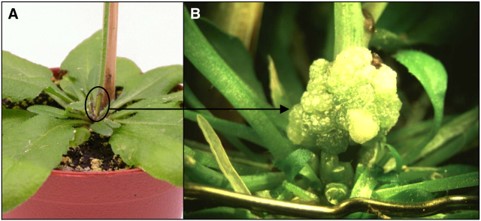Differential roles of glucosinolates and camalexin at different stages of Agrobacterium-mediated transformation
Po-Yuan Shih, Shu- Jen Chou, Caroline Müller, Barbara Ann Halkier, Rosalia Deeken, Erh-Min Lai, (2018), Molecular Plant Pathology (In press)
DOI:10.1111/mpp.12672
The plant pathogen Agrobacterium tumefaciens has the extraordinary ability to transfer to and express genes in host plant cells, resulting in the formation of tumors (galls) or hairy roots. The response of plants to the infection is complex and not completely understood. This study shows for the first time that genes encoding proteins in the synthesis and modification of indole glucosinolates and camalexin were transcriptionally activated shortly after Agrobacterium inoculation, and that indole glucosinolates reduced the efficiency of the Agrobacterium DNA transfer at early stages whereas camalexin restricted the tumor development at later stages of the infection.

Nancy A. Eckardt (2006) Plant Cell, 3350-3352
